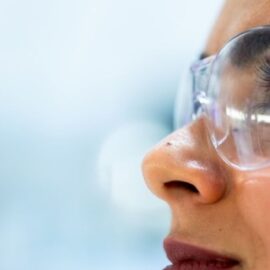
How is technology changing the world today? How will technology improve our shopping and traveling experiences? In what ways can technology reduce waste?
Change is happening faster than ever. Peter H. Diamandis and Steven Kotler envision how exponential technologies will dramatically change the world we live in, likely before the year 2030.
Let’s explore six major areas where technology will have an impact.
1) Shopping and Retail
How is technology changing the world today in terms of shopping? As technologies mature and become more widely implemented in the retail industry, Diamandis and Kotler predict that shopping will evolve in two major ways: Shopping will become mostly automated (requiring little involvement from either consumers or sellers), and it will become tailored to your personal preferences and shopping habits.
A Streamlined Shopping Experience
The authors explain that AI, with its ability to learn and adapt, will converge with other exponential technologies to automate much of our shopping experience, making the whole process more seamless and efficient. For instance:
- Smart shelves with weight sensors will automate restocking by alerting employees when products are removed.
- 3D printers will produce custom products like clothing and hardware at your local store.
- Self-driving robots will deliver items to your door.
Already, aspects of this futuristic shopping process have become reality. The authors point to the Amazon Go stores as a taste of what’s to come—you enter a store, put items into a bag, and are automatically charged for the items you take when you exit through the gate.
Personalized Recommendations
Diamandis and Kotler write that not only will shopping become largely automated, but you’ll also be making fewer shopping decisions. AI algorithms will be able to analyze your shopping history, browsing behavior, and so on, and will learn your preferences over time. With these capabilities, AI will become a digital personal assistant of sorts. For example, it will be able to order products you routinely buy without your oversight and make product suggestions based on the data it’s collected about your tastes and preferences.
2) Entertainment and Education
According to Diamandis and Kotler, in the not-too-distant future, the ways we learn and entertain ourselves will also transform dramatically due to exponential technologies. They argue that entertainment and education will become highly interactive and immersive thanks to two major technologies:
- Virtual Reality (VR): VR allows you to insert yourself into a computer generated world and interact with characters and diverse settings as if you’re truly there.
- Augmented Reality (AR): AR melds the digital and physical world. AR glasses and contact lenses will overlay digital images and information onto our actual environment.
Interactive Content
Traditional forms of entertainment (like watching TV, for example) are passive: You simply observe what’s in front of you without being directly involved. However, the authors write that in the future, you’ll no longer be a passive observer of content but instead, an active participant.
Diamandis and Kotler explain that with advances in artificial intelligence, sensors, and VR, content will be able to change based on factors such as your reactions, personality, and so on. Virtual reality sets are already being used in a variety of ways to achieve this—some video games, for instance, change the gameplay based on your heart rate and other physical reactions—and they’re getting even more immersive. Researchers are developing technologies like full body haptic suits to simulate touch as well as scent generators to simulate smell, further blurring the line between audience and content.
Multisensory Learning
The authors write that in education, VR and AR can help people learn better by providing immersive, interactive, and adaptable experiences, bridging the gap between theory and practice.
First, researchers argue that the multisensory learning that VR and AR can provide is more effective than any other form of learning. Virtual classrooms can put students in immersive teaching environments—allowing them to take history lessons on a Civil War battlefield, for instance. Similarly, an AR-enhanced museum could give students access to multimedia content related to exhibits, allowing them to interact with objects in ways not possible in a traditional museum.
Second, Diamandis and Kotler write that VR is effective at teaching empathy, which can help students understand difficult topics like homelessness and racism. By simulating experiences and environments, VR allows users to virtually step into someone else’s shoes and experience their realities firsthand, promoting a deeper level of understanding and awareness.
3) Food and the Environment
The authors argue that exponential technologies are paving the way toward a future where we’re less wasteful in the ways we produce and consume food. Technological advances are pioneering better ways to feed a growing global population while also reducing damage to the environment. Specifically, exponential technologies are countering two major issues tied to conventional methods of food production and consumption: waste and the inefficient use of resources.
Wasteful Production and Consumption
Diamandis and Kotler note that traditional agriculture methods lead to waste in both production and consumption. In the United States, only 60% of the food that’s produced is actually eaten—the rest is either left unharvested or is thrown out by consumers. Yet, despite the fact that the country produces vastly more food than it consumes, many people struggle with food insecurity.
The authors discuss two innovations aimed at reducing waste:
1. Improving photosynthesis. Researchers are exploring ways to increase crop yields by enhancing photosynthesis—the biological process carried out by plants that allows them to turn light energy (usually from the sun) into chemical energy in the form of glucose. Currently, all foods we eat depend on this process—we eat either plants or animals that eat plants. The problem is that photosynthesis isn’t efficient: Less than 1% of sunlight that reaches earth is photosynthesized. To confront this, some researchers have figured out how to genetically modify plants to have higher levels of a protein that aids in photosynthesis, allowing plants to harness more of the available solar energy and produce larger harvests.
2. Developing artificial cutin. Fruits and vegetables produce a material in their peel called cutin that protects them from spoiling. Scientists have manufactured an artificial cutin that’s organic and can coat food to provide an extra layer of protection, preserving the freshness of foods longer. This helps prevent food from going bad before we can eat it, reducing waste.
Inefficient Use of Natural Resources
Diamandis and Kotler write that our methods for producing food are highly resource intensive. Half of the world’s habitable land is used for agriculture, and meat production accounts for 70% global water use. Additionally, most foods must be transported great distances from farm to grocery store, which requires a significant expenditure of time and energy.
However, Diamandis and Kotler write that there are two technological innovations poised to reduce the land and water needed to produce food:
1. Cultured meats. Scientists are researching how to grow meat (a steak, for instance) from stem cells to reduce our reliance on the inefficient process of raising and slaughtering animals. The authors note that this process uses far fewer resources like water and land, making it sustainable and affordable as well as more humane.
2. Vertical farming. In this approach, crops are grown inside a skyscraper, where conditions such as light and temperature can be controlled. Vertical farming requires less land and water, and it isn’t affected by the weather. Additionally, because vertical farming allows crops to be grown close to city centers, it also reduces the transportation necessary to get products to consumers, thereby reducing energy use.
4) Health Care and Medicine
The health care sector is also being transformed: According to Diamandis and Kotler, converging, exponential technologies are creating a health care system that’s personalized, proactive, and affordable.
Preventive and Personalized Care
The authors write that health care today is largely reactive rather than preventive: We often seek medical intervention after manifesting symptoms of diseases and illnesses. However, exponential technologies will help transform this reactive approach into a proactive one in several ways.
Diamandis and Kotler write that with the development of body sensors and wearable technology, you’ll be able to monitor your health in real time and with increasing accuracy and detail. These technologies can keep track of vital health metrics (ranging from glucose levels to heart rate), and they can analyze this data for early signs of illnesses or disease. They can possibly even alert you if you’ve contracted a virus, allowing timely and preventive treatments that can improve health and reduce costs.
Diamandis and Kotler add that advances in genomics and gene therapy will enable us to tackle diseases before people even manifest symptoms. For example, the emerging gene-editing tool called CRISPR can adjust DNA sequences, potentially allowing us to “switch off” harmful genetic traits and thereby fight debilitating genetic diseases.
Some companies (such as Human Longevity Inc. cofounded by Diamandis) offer extensive health scanning services that aim to provide you an in-depth health profile by mapping your entire genome as well as performing other body scans and blood tests. This allows you to identify potential genetic predispositions to certain illnesses or detect early signs of disease. Health care professionals can also create custom treatment plans based on your individual genetic profile. This personalized health care approach can significantly improve your health and the efficiency of treatment.
Robot-Assisted Procedures and Artificial Replacement Parts
Diamandis and Kotler write that exponential technologies will also take over aspects of medical procedures previously overseen entirely by humans.
First, researchers are developing robots that can assist surgeons during operations. Robots can conduct intricate surgeries with high precision, potentially reducing the risk of human-related errors. Additionally, advances in nanotechnology (the manipulation of materials on an atomic scale) are leading to the creation of microbots, which can enter the body to perform treatments and conduct minimally invasive procedures.
Second, Diamandis and Kotler write that these new technologies will be able to create usable body parts. Instead of relying on donors for transplants (which is costly in time and money), scientists are researching ways to bioengineer organs from stem cells. Moreover, they’ll be able to print 3D prosthetics quickly and affordably, providing a vast improvement over conventional methods of manufacturing prosthetics.
5) Movement and Space
According to Diamandis and Kotler, advances in sensor technologies, artificial intelligence, and other technologies will allow us to travel faster and farther. They’ll also create opportunities to explore and inhabit new spaces—both real and simulated.
Unprecedented Travel Speeds
The authors write that we’ll be able to travel greater distances in significantly less time, increasing our access to resources and changing where we live, work, vacation, and so on. The authors outline some future modes of transportation that will contribute to this revolution:
1. Autonomous vehicles: The authors predict that self-driving vehicles that don’t require human intervention to get from one location to another will soon be the dominant form of transportation. These vehicles will be made possible through the convergence of technologies such as sensors and artificial intelligence. Eventually, this shift will extend to autonomous flight vehicles, opening up a new transportation network in the sky.
2. High-speed travel: At present, airplanes are the fastest mode of transportation. However, Diamandis and Kotler argue that advancing technologies will soon change this. Visionaries like Elon Musk (the founder of SpaceX) have been working to make high-speed trains and rocket travel a reality. SpaceX’s Starship is one example of this ambition, aiming to enable high-speed travel across Earth—allowing you to travel across the globe within an hour, for instance.
New Real and Virtual Spaces
Diamandis and Kotler write that exponential technologies will also allow us to inhabit new spaces. For example, advances in structural engineering and materials science could allow us to design and construct sustainable cities that float on the ocean. These cities could provide additional living spaces for the growing global population.
Perhaps the most revolutionary expansion of “livable space” may come from technological breakthroughs in virtual reality. As VR becomes increasingly sophisticated, we may spend more time in simulated environments—whether we’re shopping or holding a meeting with colleagues. We may even one day be able to use brain-computer interfaces (BCIs) to link our minds with computers.
6) Money and Finance
For centuries, banks have been in charge of our money: We rely on them to verify, record, and update our financial transactions. However, Diamandis and Kotler argue that with the advent of digital currencies and blockchain technology, banks will no longer be critical to our financial dealings. Instead, money and finance will become increasingly decentralized and personalized.
The authors explain that a digital currency is a type of money that only exists online. Digital currencies, like Bitcoin, allow people to make real-time transactions directly with one another without a bank’s involvement. This has a host of benefits, according to the authors. For example, digital currencies provide people without bank accounts a way to store money, and they save people money by eliminating bank transaction fees.
The underlying technology that makes digital currency possible is called a blockchain, which Diamandis and Kotler explain is essentially a massive digital ledger that verifies and records Bitcoin transactions using a secure network of computers. Every transaction ever made adds a “block” to existing blocks, resulting in a chain that anyone can review. This makes it more transparent than traditional banking systems.
The authors add that AI will further refine these new financial systems. AI could give us personalized financial advice, helping us make better decisions about our money without a financial adviser. AI can also make peer-to-peer loans and transactions safer by checking a person’s background and generating an accurate picture of their trustworthiness.






